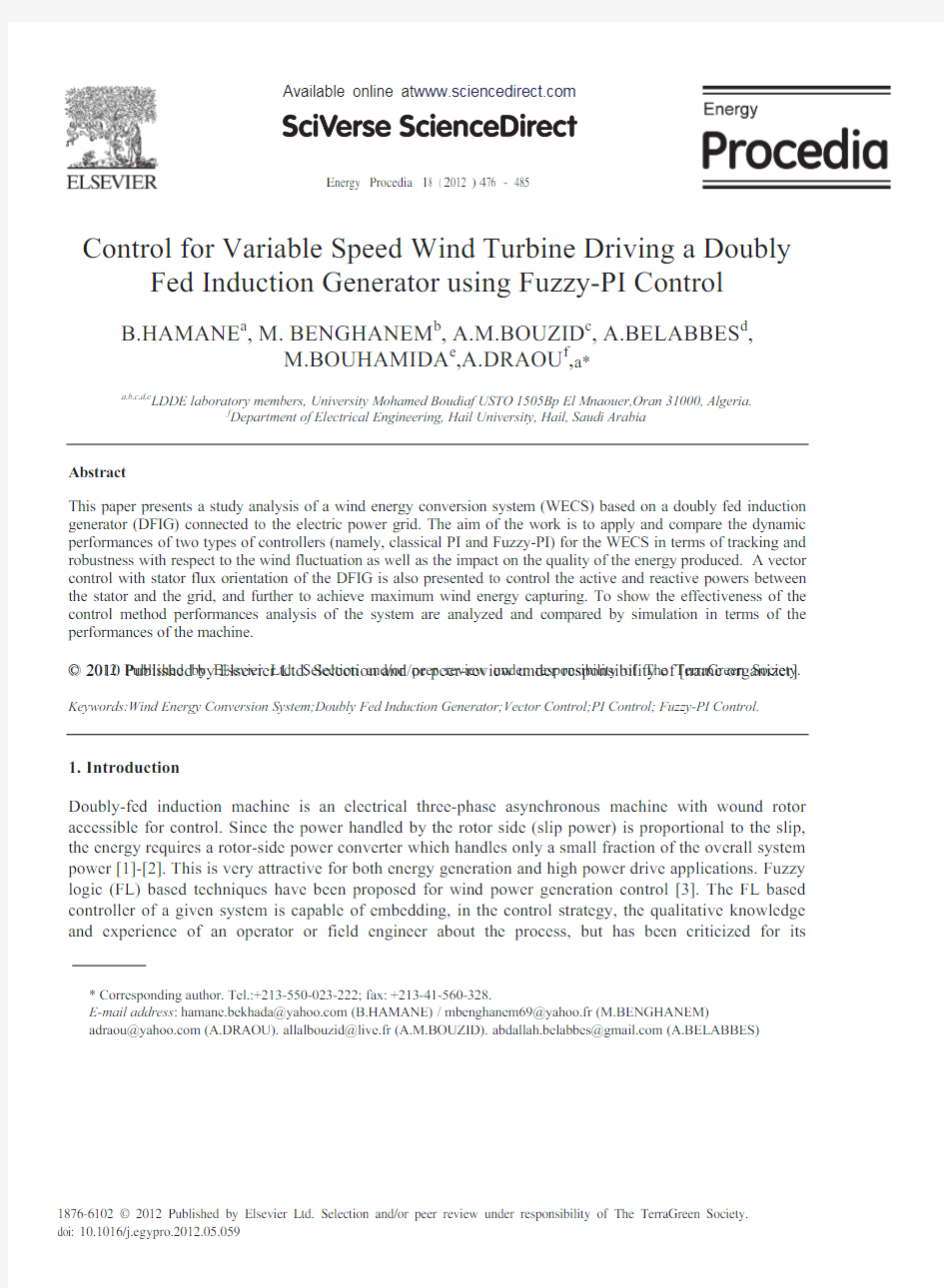专业英语论文原文

- 1、下载文档前请自行甄别文档内容的完整性,平台不提供额外的编辑、内容补充、找答案等附加服务。
- 2、"仅部分预览"的文档,不可在线预览部分如存在完整性等问题,可反馈申请退款(可完整预览的文档不适用该条件!)。
- 3、如文档侵犯您的权益,请联系客服反馈,我们会尽快为您处理(人工客服工作时间:9:00-18:30)。
E nergy Procedia 18 ( 2012 )476 – 485
1876-6102 © 2012 Published by Elsevier Ltd. Selection and/or peer review under responsibility of The TerraGreen Society.doi: 1
0.1016/j.egypro.2012.05.059
Available online at
B.HAMANE et al. / E nergy Procedia 18 ( 2012 )476 – 485 477
Fig.1.Doubly Fed Induction Generator(DFIG)
Nomenclature
qr
dr V,Stator and rotor voltage components in the d-q reference frame.
I,Stator and rotor current components in the d-q reference frame.
qr
dr,Stator and rotor flux components in the d-q reference frame.
qr
r Stator frequency,rotor rotating speed and mechanical rotor speed respectively.
Respectively slip and Number of pole pairs.
Active reactive stator power and turbine mechanic power respectively.
478 B .HAMANE et al. / E nergy Procedia 18 ( 2012 ) 476 – 485
Example of C p ()curve
Model of DFIG
rotating field reference frame,the model of the DFIG is shown in Figure 3:
Model of the DFIG
rotor voltage equations and flux components are given below [14]:ds m dr r dr qr m qs s qs
dr m ds s ds
qr
r s
dr
ds
s qs
qs
s ds
LmI I L I L I L I L I L I L I L dt
d dt
d dt
d )(
B.HAMANE et al. / E nergy Procedia 18 ( 2012 )476 – 485 479 represents the control of the active and reactive power of DFIG:
power between the stator and the network
480B.HAMANE et al. / E nergy Procedia 18 ( 2012 )476 – 485
In steady state,the second derivative terms in(12)are nil.The third terms constitutes cross-coupling terms.The block-diagram representing the internal model of the system is presented in Figure5.The input blocks relating to represent the simplified rotor converter model.Knowing equations(11) and(12),it is then possible to synthesize the regulators.
Fig.5.Block diagram of the power system
4.Controllers Synthesis
This section deals with the synthesis of PI and Fuzzy-PI controllers.Both controllers are designed to achieve the following control objectives[12]:
Performing active and reactive power reference tracking;
Efficient disturbance rejection;
Parametric robustness.
The first objective induces fast dynamics of the transient response but it may lead to few tuning parameters with explicit action on the dynamical response.The second objective takes into account the non-linearity and cross-coupling terms.Finally,the last objective is to give parametric insensibility properties to the closed-loop against over-heating and ageing.And for that,we will synthesize two controllers namely,PI and Fuzzy-PI.
A.PI controller design
The power block diagram is equivalent on each axis to a first order transfer function as shown in Figure 6[12].
Fig.6.Equivalent PI control scheme
